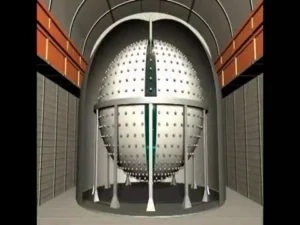
For five billion years the Sun has been the main energy source of our planet, as well as the purse of life on Earth.
[Our Sun] is just one among the hundred billion stars of our galaxy, but it’s the nearest and the only one we may thoroughly understand.At the naked eye the Sun appears as a bright ball, but through telescopes and satellites we find out that the surface is constantly distressed by the effects of the high temperature, around 5,500 degrees, and the strong magnetic fields. Huge solar flares can extend four million kilometers out of the surface, raising [particles] wind and sunspots, magnetic storms and polar lights.
Thanks to observations in visible, infrared and ultraviolet light, we deeply know the Sun surface, although we are not able to see directly its internal structure because the solar plasma is not transparent to light.
According to the theory, just under the surface there is a convective zone where solar matter is constantly in motion as a boiling pot and, in the inner layers, [there is] a radiative zone where everything is stuck by the huge pressure, and the energy is transported only by the light.
Nuclear reactions feeding the Sun are focused in the core. A central region very small in volume, less than 1% of the total volume, but whose density is 150 times higher than that of water.
Every second, 600 million tons of hydrogen are converted into helium 4, producing energy and neutrinos.
Energy is mainly produced by a series of nuclear fusion called proton-proton chain, in which four protons, at the end of the process, turn into a nucleus of helium producing energy and neutrinos.
Among these reactions, the ones connected to the emission of neutrinos are fundamental in the understanding of the internal burning of the Sun.
Many nuclear reactions produce neutrinos, which enable us to make an experimental study of the internal structure of the Sun, thus verifying if our star really works as assumed.
Neutrinos are very unique particles. There are three different types. Very tiny and capable to cross huge thickness of material without any interaction, they can leave the Sun very easily. In eight minutes solar neutrinos reach the earth, traveling almost at the speed of light, changing type continuously. This phenomenon, called “neutrino oscillation”, is of primary importance for astroparticle physics and proves that neutrinos have a mass, although incredibly small – at least 1 billion times less than that of an atom.
The best way to observe neutrinos is going underground in order to shield detectors from the continuous cosmic rays flux, coming from the space. Inside the Gran Sasso National Laboratory [LNGS] of the [Italian] National Institute for Nuclear Physics [INFN] is installed the most sensitive solar neutrinos detector of the world: Borexino.
It consists of big steel sphere with 2200 phototubes – extremely sensitive eyes, able to capture photons emitted by the rare interactions of neutrinos with a liquid inside the sphere. The liquid, known as “scintillator“, is a particular hydrocarbon, thousand million times less radioactive of a glass of pure mineral water. For about 15 years researchers and engineers working for the Borexino experiment have developed innovative techniques of purification and measurements needed to reach this goal.
Today, the heart of Borexino is probably the less radioactive place of the whole universe, as well as the only device able to observe – in real time – low energy solar neutrinos.
Borexino has been built by an international collaboration of [over] 100 physicists coming from seven countries, while the Italian collaboration consists of the researchers of the National Institute for Nuclear Physics [INFN] and the Universities of Genova, Milano and Perugia.
Every day, among the billion of billions neutrinos which cross Borexino, only 50 interact with the electrons of the scintillator, causing the emission of a prompt and weak light pulse.
The scintillator and the phototubes, controlled by 35 computers and a specific electronics, which analyzes the signals in less than 50 billions of a second, enable us to look at the heart of the Sun through neutrinos.
Borexino has been taken data since 2007, and already obtained significant results about the Sun and neutrino properties. In the next future it will tell us if our knowledge of the Sun can be considered complete or – as often happened in the past – our star will surprise us, suggesting new exciting ideas.
Video by:
Dipartimento di Fisica Università di Milano
Laboratori Nazionali del Gran Sasso
Istituto Nazionale di Fisica Nucleare
Versione in Italiano:
Pingback:Video: La natura del Sole e dei neutrini - L' esperimento Borexino